JVC KS-A Series Power Amplifiers
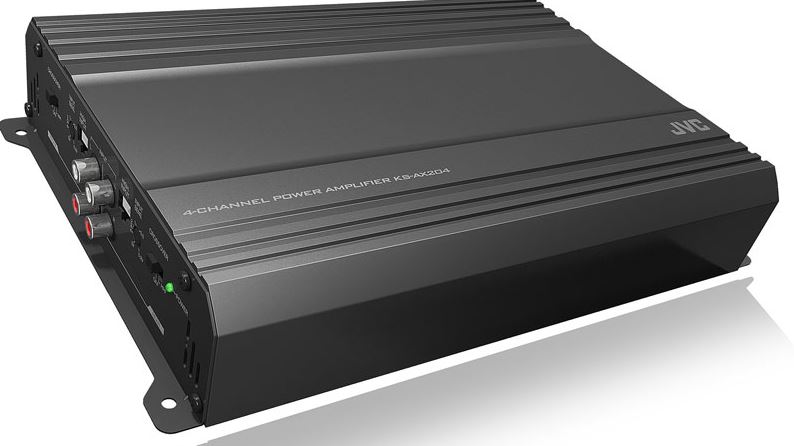
About JVC
JVC (JVCKENWOOD Europe B.V.) is JVCKENWOOD Corporation’s wholly owned subsidiary. JVC is a renowned creator and manufacturer of sophisticated audio and video products that employ cutting-edge technologies to produce high-quality sound and visuals.
JVC provides high-definition displays and home theater projectors, digital video camcorders, home theater systems, audio components and systems, portable audio products, digital storage devices, audio and video accessories, and automobile audio/video products in its consumer products.
Thank you for purchasing a JVC product.
If you have any questions or require information regarding installation kits, consult your “JVC INCAR ENTERTAINMENT” or a company supplying the kits.
For safety…
- Stop the car before performing any complicated operations.
CAUTIONS AND NOTES
- This unit is designed to operate on 12 V DC, NEGATIVE ground electrical systems. JVC recommends consulting a qualified technician for installation.
- This unit uses BTL (Balanced Transformerless) amplifier circuitry, i.e., floating ground system, to comply with the following:
- Do not connect the “©” terminals of the speakers to each other.
- Do not connect the “terminals of the speakers to the metal body or chassis.
- Cover the unused leads with insulating tape to prevent them from short-circuiting.
- When an extension lead is used, it should be as thick and short as possible; connect it firmly with insulating tape.
- Be sure to leave an appropriate space between the antenna (aerial) and the wires of this unit.
- If the fuse blows, first make sure the wires aren’t touching to cause a short circuit then replace the old fuse with one with the same rating.
- Do not let pebbles, sand, or metallic objects get inside the unit.
- To keep the heat dissipation mechanism running effectively, wipe the accumulated dust off periodically.
- Listening to the tape, radio, CD or digital audio player, etc. with the volume set at a high level for a long period of time will exhaust the battery, while the engine is turned off or while the engine is idling.
- This unit becomes very hot. Be careful not to touch the unit not only when using but after using. DO NOT disassemble the unit since there are no user-serviceable parts inside.
INSTALLATION
The following illustration shows a typical installation. However, you should make adjustments corresponding to your specific car.

- Mount this unit on a firm surface, such as in the trunk or under the front seat.
- Since heat is generated in the unit, do not mount it near inflammable objects. In addition, mount it in an area that will not prevent the unit from dissipating the heat.
- Do not mount the unit in places subject to heat: near a radiator, in a glove compartment, or in insulated areas such as under a car mat that will prevent the unit from dissipating heat.
- When mounting the unit under the front seat, make sure that adjusting the seat position will not catch any wire of the unit.

- When mounting this unit, be sure to use the provided screws.
- If any other screws are used, there is a risk of loosening the unit or damaging the parts under the car floor.
- Before drilling holes in the trunk to install the unit, make sure that there is sufficient space under the trunk so that you do not drill holes in the fuel tank, etc.
SAFETY INSTRUCTIONS “SOME DOS AND DON’TS ON THE SAFE USE OF EQUIPMENT”
This equipment has been designed and manufactured to meet international safety standards but, like any electrical equipment, care must be taken if you are to obtain the best results and safety is to be assured.
- DO read the operating instructions before you attempt to use the equipment.
- DO ensure that all electrical connections (including the mains plug, extension leads, and interconnections between pieces of equipment) are properly made and in accordance with the manufacturer’s instructions. Switch off and withdraw the mains plug when making or changing connections.
- DO consult your dealer if you are ever in doubt about the installation, operation, or safety of your equipment.
- DO be careful with glass panels or doors on equipment.
- DON’T continue to operate the equipment if you are in any doubt about it working normally, or if it is damaged in any way-switch off, withdraw the mains plug, and consult your dealer.
- DON’T remove any fixed cover as this may expose dangerous voltages.
- DON’T leave equipment switched on when it is unattended unless it is specifically stated that it is designed for unattended operation or has a standby mode. Switch off using the switch on the equipment and make sure that your family knows how to do this. Special arrangements may need to be made for infirm or handicapped people.
- DON’T use equipment such as personal stereos or radios so that you are distracted from the requirements of traffic safety. It is illegal to watch television whilst driving.
- DON’T listen to headphones at high volume as such use can permanently damage your hearing.
- DON’T obstruct the ventilation of the equipment, for example with curtains or soft furnishings. Overheating will cause damage and shorten the life of the equipment.
- DON’T use makeshift stands and NEVER fix legs with wood screws to ensure complete safety always fit the manufacturer’s approved stand or legs with the fixings provided according to the instructions.
- DON’T allow electrical equipment to be exposed to rain or moisture. ABOVE ALL
- NEVER let anyone, especially children, push anything into holes, slots, or any other opening in the case – this could result in a fatal electrical shock.
- NEVER guess or take chances with electrical equipment of any kind it is better to be safe than sorry!
POWER SUPPLY
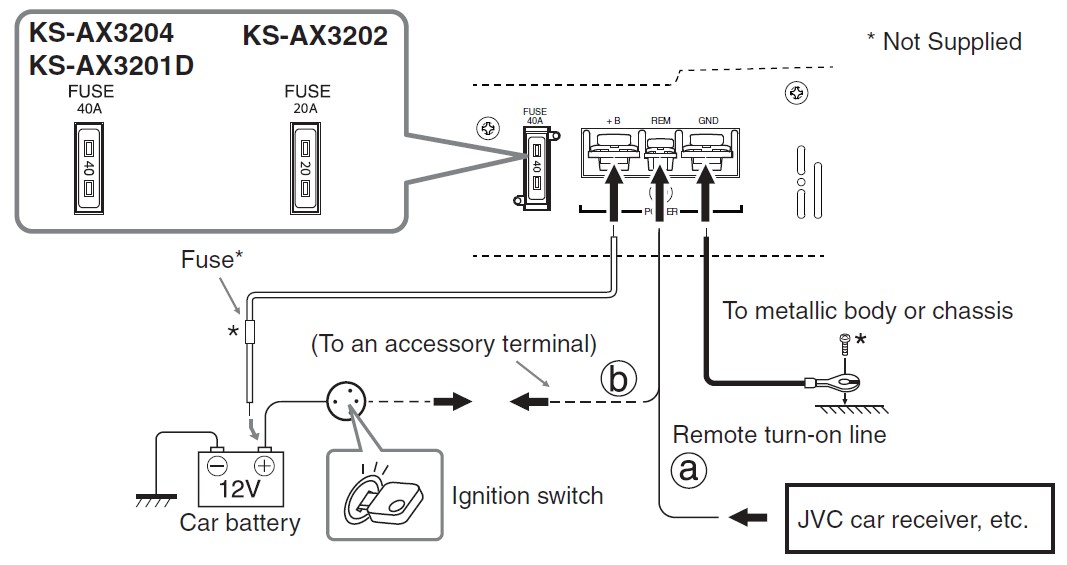
Caution
To prevent short circuits while making connections, keep the battery’s negative terminal disconnected.
- When using a power cord (purchased separately), be sure to place the fuse near the battery as shown.
- Connect the lead wire (power cord) through which power is supplied directly to the battery’s “terminal only after all the other connections have been made.
The proper lead wire connected to each POWER terminal is as follows.
- + B and GND: AWG 8 to AWG 4 (The cross section is about 8 mm? to 21 mm2.)
- REM: AWG 18 to AWG 8 (The cross section is about 0.8 mm? to 8 mm2.)
When you use a JVC car receiver with a remote lead, connect to the REM terminal on this unit.
When you connect a unit without a remote lead, connect it to the accessory circuit of the car which is activated by the ignition switch. In this case, noise may occur when the car receiver is turned on or off. To avoid this noise, do not turn on or off the car receiver itself. You can turn on or off the car receiver along with the on/off operation of the ignition switch.
TERMINAL CONNECTIONS
When making terminal connections, properly fix each terminal with the provided screw by turning it as illustrated.
- Use ring terminals (not provided) for secure connection.
Notes
- Make sure the screw is fixed in place to prevent disconnections.
- Avoid over-tightening as it may cause damage to the screw or its head slot.
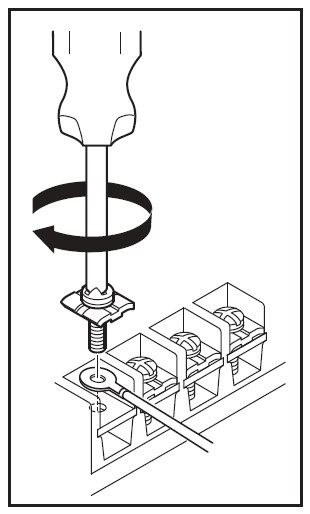
SPEAKER SYSTEMS
Notes
- Be sure not to connect the terminals of the speakers to a common point.
- If the same lead is used for both left/right or front/rear speaker wirings, this unit cannot be used. Always use independent leads for each speaker. In this case, redo the wirings.
- Use the speakers with an impedance of 2 2 to 8 2 (4 82 to 8 2: when used in Bridge Mode).
- Use speakers which have sufficient capacity for the unit.
The proper lead connected to each SPEAKER OUTPUT terminal is as follows. KS-AX3204/KS-AX3202: AWG 18 to AWG 12 (The cross section is about 0.8 mm2 to 3.3 mm?). KS-AX3201D: AWG 18 to AWG 8 (The cross section is about 0.8 mm? to 8 mm?).
Declaration of Conformity with regard to the MC Directive 2004/108/EC
Manufacturer: JVC KENWOOD Corporation 3-12, Moriyacho, Kanagawa-ku, Yokohama-shi, Kanagawa 221-0022, Japan EU Representative’s: JVC Technical Services Europe GmbH Postfach 10 05 04, 61145 Friedberg, Germany.
Dear JVC Customer in the USA,
We suggest that you register your product since it will enable us to contact you directly if it is ever necessary to correct a safety-related condition in your product. You can register at www.register.jvc.com Please note that failure to register does not diminish any of your rights during the warranty period.
Information on Disposal of Old Electrical and Electronic Equipment (applicable for countries that have adopted separate waste collection systems)
Products with the symbol (crossed-out wheeled bin) cannot be disposed of as household waste. Old electrical and electronic equipment should be recycled at a facility capable of handling these items and their waste by-products. Contact your local authority for details on locating a recycling facility nearest to you. Proper recycling and waste disposal will help conserve resources whilst preventing detrimental effects on our health and the environment.
SPEAKER CONNECTIONS
Connection varies depending on the number of speakers used in your car. Select the appropriate connection referring to the following diagrams.
Notes:
- Securely connect all the parts. If the connections are loose, due to contact resistance etc., heat will break out and may cause an accident.
- Run the connection leads under the car mats to prevent accidental disconnections.
- When your receiver is equipped with a line output.
- When your receiver is NOT equipped with a line output.

- Connect each lead of the speaker input connector to a speaker positive lead or chassis*1 of the receiver.
- Cover the terminals of unused speaker negative leads of the receiver with insulating tape to prevent short circuits.

KS-AX3204
4-speaker system–Normal Mode
- Use the speakers with an impedance of 2 2 to 8 22.
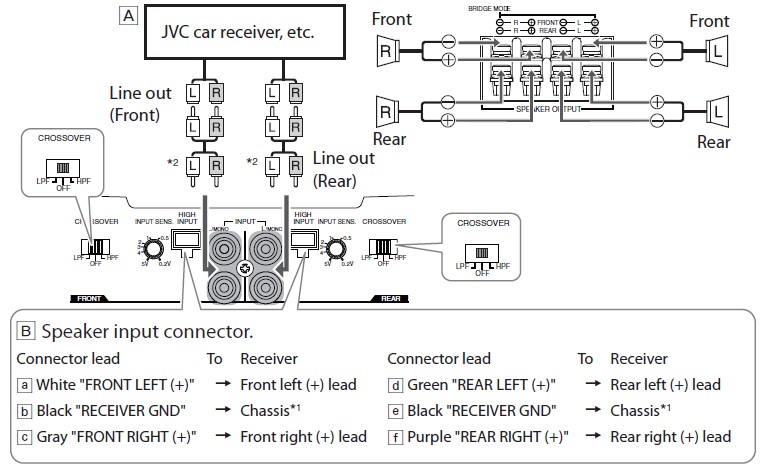
2-speaker system plus subwoofer–Bridge Mode
- Use the speakers with an impedance of 2 82 to 8 52.
- Use the subwoofer with an impedance of 4 2 to 8 02.
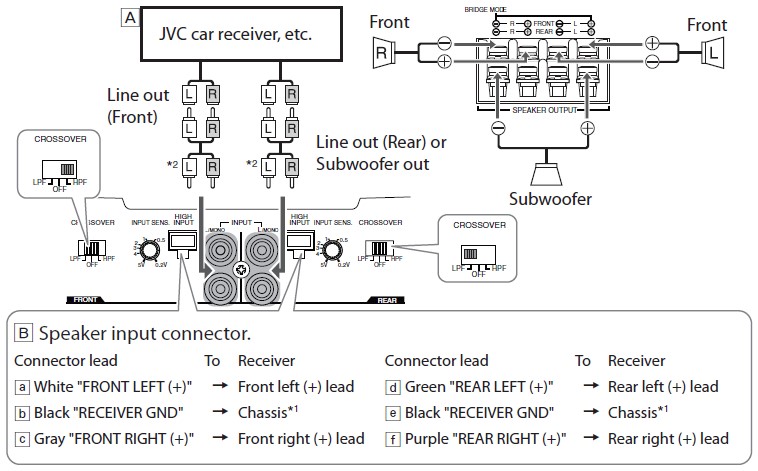
2-speaker system–Bridge Mode
- Use the speakers with an impedance of 4 82 to 8 92.
- Be sure to connect the line output from the receiver to the left (L) jack on this unit.
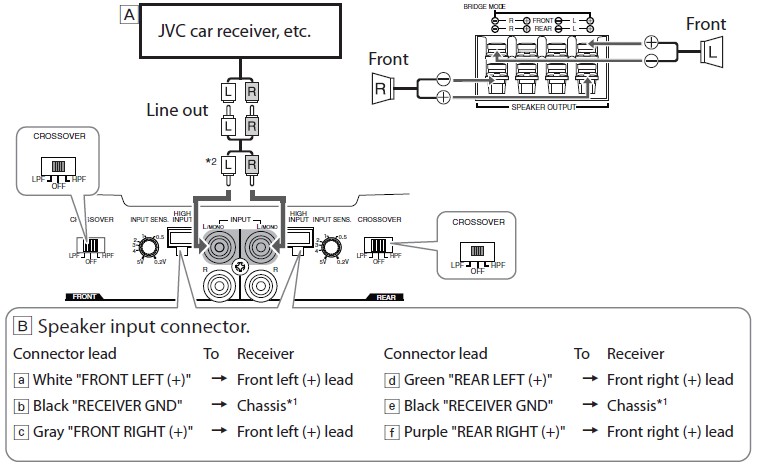
KS-AX3202
2-speaker system–Normal Mode
- Use the speakers with an impedance of 2 2 to 8 22.
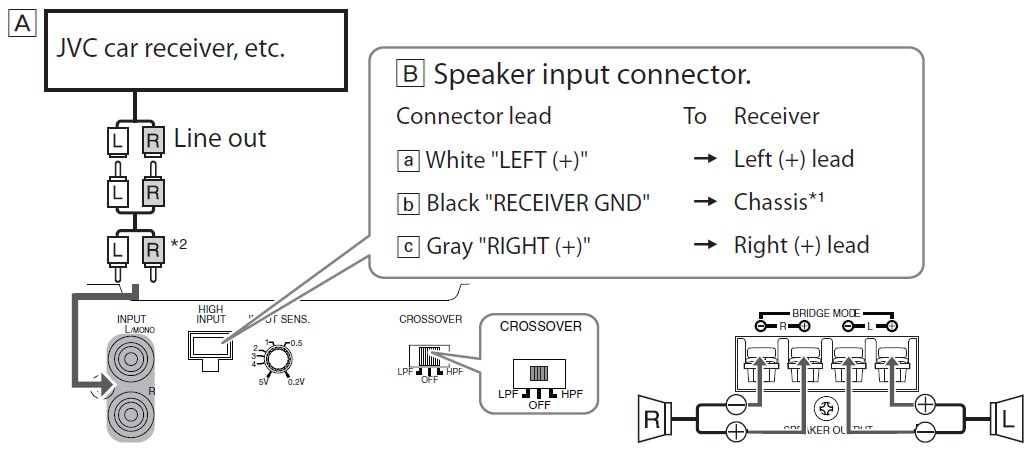
2-speaker system plus subwoofer
- Use the speakers with an impedance of 2 2 to 8 2.

Subwoofer system–Bridge Mode
- Use the speakers with an impedance of 4 2 to 8 02.

2-speaker system (2 amplifiers)-Bridge Mode
- Use the speakers with an impedance of 4 82 to 8 02.
- Be sure to connect the line output from the receiver to the left (L) jack on this unit.
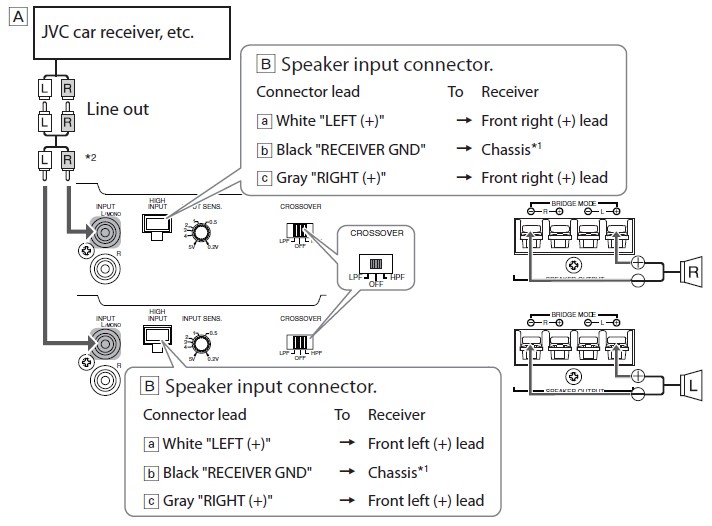
KS-AX3201D
Subwoofer system
- Use the speakers with an impedance of 2 2 to 8 22.

KS-AX3201D
2-Subwoofer system (2 amplifiers)
- Use the speakers with an impedance of 2 82 to 8 02.
- Incoming signals from INPUT jacks are emitted through the PRE OUT jacks.
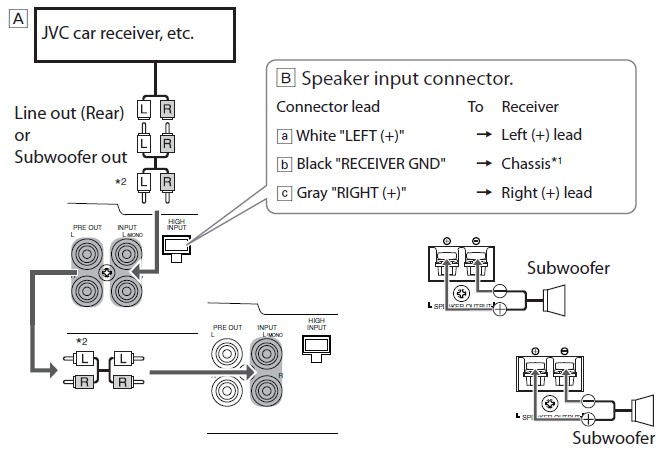
2-Subwoofer system
- Use the speakers with an impedance of 4 2 to 8 92.

5-speaker system plus subwoofer 5.1-channel (3 amplifiers)
- Use the speakers with an impedance of 2 82 to 8 02.
- Be sure to connect the line output from the receiver to the left (L) jack on this unit.

CONTROLS

- POWER indicator
The green lamp lights while the unit is turned on.
- CROSSOVER filter switch
OFF: Normally set to this position. The switch is preset to this position when the unit is shipped.
LPF: Set to this position when you want to turn on the LPF (Low-Pass Filter) switch. The Low- Pass Filter transmits frequencies lower than 80 Hz.
HPF: Set to this position when you want to turn on the HPF (High-Pass Filter) switch. The High-Pass Filter transmits frequencies higher than 150 Hz.
- INPUT SENS. (input sensitivity) controller
Set this control according to the line-output level of the center unit connected with this unit. For the line-output level, refer to the <Specifications> in the instruction manual of the center unit. If the line-output level of the center unit is unknown, set it in the following procedure:
- Turn the Input sensitivity control to “5” (minimum).
- Play a CD source.
- Increase the volume of the center unit gradually to the maximum level at which sound is not distorted.
- Turn the Input sensitivity control clockwise to a level slightly below the level at which sound starts to be distorted. This controller is preset to 5V when the unit is shipped.
- BASS BOOST controller
Turning this boosts the 45 Hz frequency within the range of 0 dB to +18 dB. Adjust the level while listening to the sound. This controller is preset to MIN when the unit is shipped.
- LPF (Low-Pass Filter) controller
Adjust the cutoff frequency (the Low-Pass Filter transmits frequencies lower than the cutoff frequency) within the range of 50 Hz to 200 Hz. Adjust the level while listening to the sound. This controller is preset to 50 Hz when the unit is shipped
TROUBLESHOOTING
The POWER indicator does not light.
- Change the fuses if the current one is blown.
- Connect the ground lead securely to a metal part of the car.
- Turn on the equipment connected to this unit.
- Confirm the battery voltage (11 V to 16 V).
- Use a relay if your system employs too many amplifiers.
- Leave the unit turned off to cool it down if it heats up abnormally. No sound is heard.
- Confirm the connections for the power supply (see “POWER SUPPLY” on page 1).
- Connect the RCA pin cords to the INPUT jacks, or the speaker input connector to the HIGH INPUT terminal. Confirm the speaker wirings and the position of the CROSSOVER filter switch (See “SPEAKER CONNECTIONS” on page 2).
Alternator noise is heard.
- Keep the leads of the POWER terminals away from the RCA pin cords.
- Keep the RCA pin cords away from other electrical cables in the car.
- Connect the ground lead securely to a metal part of the car.
- Make sure the speaker negative leads do not touch the car chassis.
- Connect a bypass capacitor across the accessory switches (horn, fan, etc….). Noise is made when you connect the unit to an AM (MW/LW) tuner.
- Move all the leads of this unit away from the antenna (aerial) lead.
Specifications

Design and specifications are subject to change without notice.
FAQS About JVC KS-A Series Power Amplifiers
Which power amplifier kind is most effective?
The Class C amplifier has the best efficiency but suffers from poor distortion and produces a lot of unwanted harmonics. Class C amplifiers have conduction angles that are much lower than 1800 and are biased to only turn on after significant signal excursions.
What is the power consumption of a power amplifier?
Be aware that a normal Class A/B amplifier has an efficiency of approximately 25%, which means that a typical 100 watt amp uses about 25 watts when it is not in use and a typical 500 watt power amp uses about 125 watts each hour.
Which class of amplifier produces the finest sound?
The Class A architecture has the finest sound fidelity but is the least efficient. Although slightly more efficient, class B design is highly distorted. Power effectiveness and good sound are provided by class AB design. Highest efficiency and smallest footprint are found in class D designs.
What is the most typical amplifier issue?
The most frequent issue that arises while using amplifiers is operator error. In other words, the speaker wires may not be connected or the speaker button may not be pressed if everything lights up but there is no sound. If not, there’s a chance the cord will be harmed or an internal fuse will explode.
What power amplifier exhibits the highest distortion?
Power Amplifier Class C
What power amplifier has the lowest distortion?
Class A power source
What frequency range does a power amplifier operate in?
Tuned power amplifiers, also known as radio power amplifiers, increase the power of radio frequency signals (3 KHz to 300 GHz). Large signal power amplifiers are another name for them.
What frequency does a power amplifier operate at?
20 Hz–20 kHz
What’s the maximum number of speakers an amplifier can support?
A generic low-impedance power amplifier allows for the use of two or four speakers simultaneously. More speakers might be needed, though, depending on the venue.
What is the source of amplifier noise?
A faulty audio connection connecting to the amplifier is one of the two main reasons of a constant humming or buzzing, or. Through an audio wire and into the amplifier, electrical noise is being sent.
What leads to the overheating of an amplifier?
The amplifier may overheat if there is a power imbalance and an excessive speaker load.
For more manuals by JVC, Visit Manualsdock
[embeddoc url=”https://manualsdock.com/wp-content/uploads/2023/08/JVC-KS-A-Series-Power-Amplifiers-User-Instructions.pdf” download=”all”]


